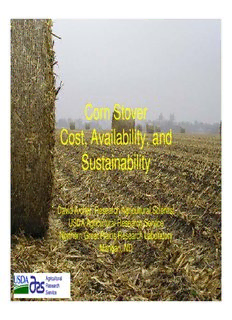
David Archer, Research Agricultural Scientist PDF
Preview David Archer, Research Agricultural Scientist
Corn Stover Cost, Availability, and Sustainability David Archer, Research Agricultural Scientist USDA Agricultural Research Service Northern Great Plains Research Laboratory Mandan, ND Agricultural AAggrriiccRuullettuusrreaaall rch RReesseeSaarreccrhhv ice SSeerrvviiccee Points Favoring Harvest of Crop Residues • Renewable • Doesn’t require use of additional land • Vast quantities produced • May facilitate adoption of less-intensive tillage Agricultural Research Service 2007 Corn ~300-350 million tons of stover grown in U.S. Midwest (13 States) Totals: 73.6 million acres 11.4 billion bushels U.S. Totals: 86.5 million acres 13.1 billion bushels Source: USDA-NASS Cropland Data Layer Sustainability Concerns with Harvesting Crop Residues • Soil quality (tilth), organic matter (carbon) sustainability • Soil structure, microbial activity • Erosion protection • Plant nutrients • Evaporation • Harvest damage (soil compaction, etc) Agricultural Research Service Biomass Gasification Demonstration and Research Facility • University of Minnesota, Morris – Plant-scale project provide up to 80 percent of campus heating and cooling – Allow research of alternative feedstocks (e.g. wood chips, grasses, wheat straw, corn cobs, corn stover) * – Require around 10,000 tons of biomass per year Photo credit: University of Minnesota Agricultural Research Service Scale-up UMM plant: ~10,000 tons/yr Chippewa Valley Ethanol Company, 100 million gallon/year Benson, MN: * cellulosic plant ~100,000 tons/yr * would require (replace natural gas) ~1 million tons/yr Agricultural Research Service 1st Step: Corn Cobs Advantages • One-pass harvest, require little change in current production practices • Relatively high volumetric energy density • Low nutrient content Agricultural Research Service 10-mile Radius Around University of Minnesota, Morris AAggrriiccuullttuurraall RReesseeaarrcchh SSeerrvviiccee Agricultural Research Service Analysis • EPIC simulation model – calibrated to USDA-ARS field research plots at Morris, MN – Simulation conducted for each SSURGO soil map unit within a 10-mile radius of UMM • Biomass farm gate cost includes: – Biomass harvest and in-field transportation – Nutrient replacement (N,P,K) – Short-term crop yield impacts Agricultural Research Service
Description: